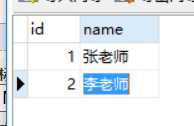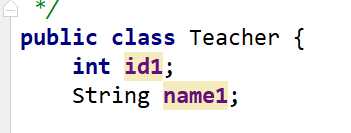标签:int 类型 联合 的区别 result namespace 6.2 void 主键
一.MyBatis 实现多表查询
1.1 业务装配.对两个表编写单表查询语句,在业务(Service)把查询的两个结果进行关联.
1.2 使用Auto Mapping特性,在实现两表联合查询时通过别名完成映射.
1.3 使用 MyBatis 的<resultMap>标签进行实现.
2.多表查询时,类中包含另一个类的对象的分类
2.1 单个对象
2.2 集合对象.
二.resultMap 标签
1. <resultMap>标签写在mapper.xml中,由程序员控制SQL查询结果与实体类的映射关系.
1.1 默认 MyBatis 使用 Auto Mapping 特性.
2. 使用<resultMap>标签时,<select>标签不写 resultType 属性,而是使用 resultMap 属性引用<resultMap>标签.
3. 使用 resultMap 实现单表映射关系
3.1 数据库设计

3.2 实体类设计

3.3 mapper.xml 代码
<mapper namespace="com.hanlu.mapper.TeacherMapper"> <resultMap id="mymap" type="teacher"> <!--主键使用id标签配置映射关系--> <id column="id" property="id1"/> <!--其他列使用result标签配置映射关系--> <result column="name" property="name1"/> </resultMap> <select id="selAll" resultMap="mymap"> SELECT * FROM teacher </select> <!-- 与上面的代码可以完成相同的映射 此代码是 Auto Mapping 属性名和表的列名相一致
<select id="selAll" resultType="teacher"> SELECT * FROM teacher </select>--> </mapper>
4.使用 resultMap 实现关联单个对象(N+1)
4.1 N+1 查询方式,先查询出某个表的全部信息,根据这个表的信息查询另一个表的信息.
4.2 与业务装配的区别:
4.2.1 在 service 里面写的代码,由 mybatis 完成装配
4.3 实现步骤:
4.3.1 在 Student 实现类中包含了一个Teacher 对象
public class Student { private int id; private String name; private int age; private int tid; private Teacher teacher; @Override public String toString() { return "Student{" + "id=" + id + ", name=‘" + name + ‘\‘‘ + ", age=" + age + ", tid=" + tid + ", teacher=" + teacher + ‘}‘; } public int getId() { return id; } public void setId(int id) { this.id = id; } public String getName() { return name; } public void setName(String name) { this.name = name; } public int getAge() { return age; } public void setAge(int age) { this.age = age; } public int getTid() { return tid; } public void setTid(int tid) { this.tid = tid; } public Teacher getTeacher() { return teacher; } public void setTeacher(Teacher teacher) { this.teacher = teacher; } }
4.3 .2 在TeacherMapper 中提供一个查询
<select id="selById" resultType="teacher" parameterType="int"> select * from teacher where id=#{0} </select>
4.3.3 在StudentMapper 中
4.3.3.1 <association> 装配一个对象时使用
4.3.3.2 property:对象在类中的属性名
4.3.3.3 select:通过哪个查询查询出这个对象的信息
4.3.3.4 column: 把当前表的哪个列的值作为参数传递给另一个查询
4.3.3.5 大前提使用 N+1 方式时。如果列名和属性名相同可以不配置,使用 Auto Mapping 特性。但是 mybatis 默认只会给列专配一次
<resultMap type="student" id="stuMap"> <id property="id" column="id"/> <result property="name" column="name"/> <result property="age" column="age"/> <result property="tid" column="tid"/> <!-- 如果关联一个对象 --> <association property="teacher" select="com.hanlu.mapper.TeacherMapper.selById" column="tid"></association> </resultMap> <select id="selAll" resultMap="stuMap"> select * from student </select>
4.3.3.6 把上面代码简化成
<mapper namespace="com.hanlu.mapper.StudentMapper"> <resultMap id="stuMap" type="student"> <result column="tid" property="tid"/> <!--如果关联一个对象--> <association property="teacher" select="com.hanlu.mapper.TeacherMapper.selById" column="tid"/> </resultMap> <select id="selAll" resultMap="stuMap"> SELECT * FROM t_student </select> </mapper>
5. 使用 resultMap 实现关联单个对象(联合查询方式)
5.1 只需要编写一个 SQL,在 StudentMapper 中添加下面效果
5.1.1 <association/>只要专配一个对象就用这个标签
5.1.2 此时把<association/>小的<resultMap>看待
5.1.3 javaType 属性:<association/>专配完后返回一个什么类型的对象.取值是一个类(或类的别名)
<resultMap type="Student" id="stuMap1"> <id column="sid" property="id"/> <result column="sname" property="name"/> <result column="age" property="age"/> <result column="tid" property="tid"/> <association property="teacher" javaType="Teacher" > <id column="tid" property="id"/> <result column="tname" property="name"/> </association> </resultMap> <select id="selAll1" resultMap="stuMap1"> select s.id sid,s.name sname,age age,t.id tid,t.name tname
FROM student s left outer join
teacher t on s.tid=t.id </select>
6. N+1 方式和联合查询方式对比
6.1 N+1:需求不确定时.
6.2 联合查询:需求中确定查询时两个表一定都查询.
7. N+1 名称由来
7.1 举例:学生中有 3 条数据
7.2 需求:查询所有学生信息级授课老师信息
7.3 需要执行的 SQL 命令
7.3.1 查询全部学生信息:select * from 学生
7.3.2 执行 3 遍 select * from 老师 where id=学生的外键
7.4 使用多条 SQl 命令查询两表数据时,如果希望把需要的数据都查询出来,需要执行 N+1 条 SQl 才能把所有数据库查询出来.
7.5 缺点:
7.5.1 效率低
7.6 优点:
7.6.1 如果有的时候不需要查询学生是同时查询老师.只需要执行一个 select * from student;
7.7 适用场景: 有的时候需要查询学生同时查询老师,有的时候只需要查询学生.
7.8 如果解决 N+1 查询带来的效率低的问题
7.8.1 默认带的前提: 每次都是两个都查询.
7.8.2 使用两表联合查询.
标签:int 类型 联合 的区别 result namespace 6.2 void 主键
原文地址:https://www.cnblogs.com/hanlu0516/p/10010446.html